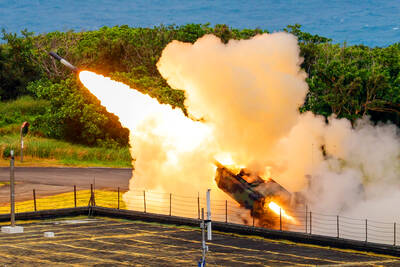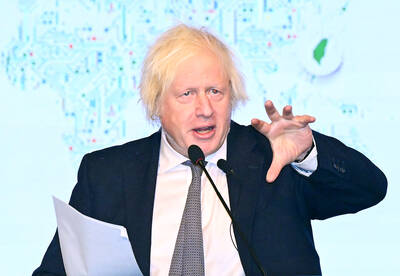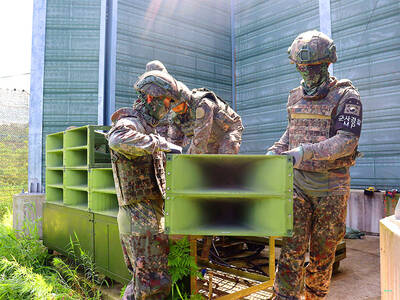Despite the rapidly slowing economy, an army of cranes still moves busily above the archipelago of factories that Sharp is building in the gritty port of Sakai.
The US$10 billion complex, row upon row of hangar-size buildings, will produce up to 13 million liquid-crystal-display TVs a year by 2010.
If consumer demand does not rebound by then — and if prices for flat-panel sets do not stop falling — analysts say the project could end up being little more than the world’s most expensive industrial art installation. But the Japanese TV maker calls it something else: one of the keys to its survival, particularly in hard times.
“We need to take a longer-term view,” said Nobuyuki Sugano, an executive at Sharp. “If other companies slow down spending, we can stay ahead.”
Global companies are battening down the hatches — reducing spending, laying off workers and pulling back on luxuries like research and development and expansion. In the US, many seemed to support letting the automobile industry collapse under the weight of its own lethargy.
Japanese companies are also cutting back — on Dec. 10, Sony announced it would eliminate 8,000 jobs. But, armed with the lessons of their past, many Japanese companies are cutting back less than their competition, investing instead for the day the downturn ends, however long that takes.
“Unless our sales dry up completely, we have to continue investing,” said Kumiko Makino, a spokeswoman for Sanyo Electric, which has refused to cut investment in new battery and solar panel factories. “If we stop, our rivals and competitors will quickly catch up.”
That urgency stems from the bitter lessons of the stagnant 1990s. Japanese companies cut back on development, only to lose ground to hungry Taiwanese and South Korean competitors.
Many economists and industry analysts say Japanese companies have so far maintained higher levels of investments in production, research and development than companies in other countries.
Instead of huge layoffs or cuts in operations, firms are cutting part-time staff members. (Layoffs of full-time workers remain taboo.) They are also delaying or canceling fewer new plants than elsewhere.
One reason is that Japanese companies have war chests of cash built up during Japan’s recovery earlier this decade. Another is that unlike in the US, shareholders lack the power to demand that cash be paid out as dividends. If Japan’s powerful manufacturing sector has a secret to its success, it may be this willingness to reinvest a big share of profits back into new plants and research.
Japan’s drive to build bigger, more advanced factories fueled an industrial construction boom that propelled the economic recovery earlier this decade. It also equipped the nation with the most advanced factory production lines to try to defend its technological lead over the rest of Asia.
“Japan sees its future as more dependent on capex than Americans or Europeans do,” said Robert Feldman, an economist at Morgan Stanley in Japan, using the industry jargon for “capital expenditure,” investment in new factories and equipment.
Innovation grew from necessity, too. Feldman noted that with Japan’s shrinking population, companies are more likely to try to fill the gaps by investing more heavily in labor-saving machinery, like robots.
To be sure, the global slowdown has hammered Japan’s profits and sent its US$5 trillion economy, the world’s largest after the US, into recession. And economists say harder times lie ahead, with the US’ crucial Christmas shopping season looking to be one of the weakest in memory.
Overall, government figures released last month reported that corporate spending on factories and other facilities fell 2 percent in the three months ending in September from the previous quarter, for its third consecutive quarterly decline. The declines were a major factor in Japan’s sliding into recession.
Tetsufumi Yamakawa, chief Japan economist at Goldman Sachs, estimates that such investment will shrink 1.8 percent this year and 2.1 percent next year before growing slowly.
“The pace of the slowdown in capex has been much sharper than we expected,” he said.
Still, Yamakawa and other economists say they expect corporate Japan to keep outspending the US on new factories, even during the current downturn.
Last year Japan spent 16 percent of its GDP on new factories and production, Yamakawa said. While that is down from Japan’s high-growth 1980s, when it spent closer to 25 percent, the figure is still high when compared with 11 percent by the US, he said.

Authorities have detained three former Taiwan Semiconductor Manufacturing Co (TMSC, 台積電) employees on suspicion of compromising classified technology used in making 2-nanometer chips, the Taiwan High Prosecutors’ Office said yesterday. Prosecutors are holding a former TSMC engineer surnamed Chen (陳) and two recently sacked TSMC engineers, including one person surnamed Wu (吳) in detention with restricted communication, following an investigation launched on July 25, a statement said. The announcement came a day after Nikkei Asia reported on the technology theft in an exclusive story, saying TSMC had fired two workers for contravening data rules on advanced chipmaking technology. Two-nanometer wafers are the most

DEFENSE: The first set of three NASAMS that were previously purchased is expected to be delivered by the end of this year and deployed near the capital, sources said Taiwan plans to procure 28 more sets of M-142 High Mobility Artillery Rocket Systems (HIMARS), as well as nine additional sets of National Advanced Surface-to-Air Missile Systems (NASAMS), military sources said yesterday. Taiwan had previously purchased 29 HIMARS launchers from the US and received the first 11 last year. Once the planned purchases are completed and delivered, Taiwan would have 57 sets of HIMARS. The army has also increased the number of MGM-140 Army Tactical Missile Systems (ATACMS) purchased from 64 to 84, the sources added. Each HIMARS launch pod can carry six Guided Multiple Launch Rocket Systems, capable of

CHINA’s BULLYING: The former British prime minister said that he believes ‘Taiwan can and will’ protect its freedom and democracy, as its people are lovers of liberty Former British prime minister Boris Johnson yesterday said Western nations should have the courage to stand with and deepen their economic partnerships with Taiwan in the face of China’s intensified pressure. He made the remarks at the ninth Ketagalan Forum: 2025 Indo-Pacific Security Dialogue hosted by the Ministry of Foreign Affairs and the Prospect Foundation in Taipei. Johnson, who is visiting Taiwan for the first time, said he had seen Taiwan’s coastline on a screen on his indoor bicycle, but wanted to learn more about the nation, including its artificial intelligence (AI) development, the key technology of the 21st century. Calling himself an

South Korea yesterday said that it was removing loudspeakers used to blare K-pop and news reports to North Korea, as the new administration in Seoul tries to ease tensions with its bellicose neighbor. The nations, still technically at war, had already halted propaganda broadcasts along the demilitarized zone, Seoul’s military said in June after the election of South Korean President Lee Jae-myung. It said in June that Pyongyang stopped transmitting bizarre, unsettling noises along the border that had become a major nuisance for South Korean residents, a day after South Korea’s loudspeakers fell silent. “Starting today, the military has begun removing the loudspeakers,”